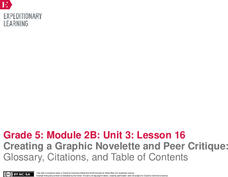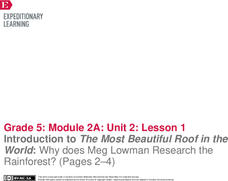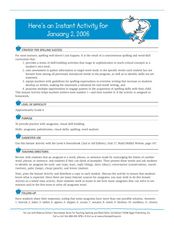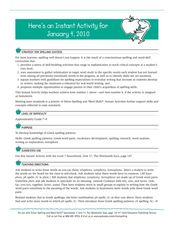EngageNY
Creating a Graphic Novelette and Peer Critique: Glossary, Citations, and Table of Contents
A, B, C ... let's alphabetize to get organized! Using the informative resource, scholars create an alphabetized glossary of key words for their graphic novelettes. Additionally, they create a table of contents and citations page.
EngageNY
Interpreting, Integrating, and Sharing Information about DDT: Using Cascading Consequences and Fishbowl Protocol
What is your interpretation? Scholars look at their Cascading Consequences Charts and interpret the information they have gathered. Learners match claims with evidence and then watch a video. At the end, they carry out a fishbowl...
James Madison Memorial Fellowship Foundation
A Picture is Worth a Thousand Words
This exercise on the Constitution requires small groups to design a visual metaphor that expresses the concept behind one of seven principles: popular sovereignty, federalism, republicanism, separation of powers, checks and balances,...
EngageNY
Reading for Gist and Answering Text-Dependent Questions: Local Sustainable Food Chain
Readers use sticky notes and a Reading Closely: Guiding Questions handout to record the gist of a different section (pages 161-166) in The Omnivore’s Dilemma. They then pair up and share their ideas. To end the lesson, readers complete...
EngageNY
Research: Paraphrasing Relevant Information
Readers take a look at the source Ethical Style: How Is My T-Shirt Made? and discuss how to say the information in the article without plagiarism. Learners make note of and underline sentences that may present a problem in paraphrasing....
EngageNY
Reading for Gist and Answering Text-Dependent Questions: Chapter 4 of World without Fish
True or false? Scholars read chapter four of World without Fish and explore the idea of a myth. They discuss in triads the meaning of the myth of nature’s bounty. Learners annotate the text on sticky notes and then answer...
EngageNY
Introduction to The Most Beautiful Roof in the World: Why does Meg Lowman Research the Rainforest? (Pages 2–4)
Let's go for a walk. Scholars take a book walk through the text The Most Beautiful Roof in the World and create an anchor chart to list the features of informational text. They then take a close look into the character Meg Lowman by...
EngageNY
Using Quotes to Explain: Why Philo Farnsworth Invented Television
Television or radio? Scholars read pages 18-28 of The Boy Who Invented TV: The Story of Philo Farnsworth to discover why Farnsworth thought TV was better than radio. They determine the gist of the section and then look closer...
EngageNY
Close Reading: “Dog Sleds” and “Kayak”
Visualize it! Scholars read pages 12–15 of The Inuit Thought of It and create a visual gist of the text. They then do a close read of the text and create a natural environment anchor chart before answering text-dependent questions.
EngageNY
Notices and Wonders of the Second Stanza of “If”
Here is an instructional activity that asks pupils to analyze poetry and sparks discussion about two different types of texts: asking how is the poem, If by Rudyard Kipling alike and different from the story, Bud, Not Buddy by...
EngageNY
End of Unit 2 Assessment, Part 2: Revise Essay Drafts
One last chance to fix it. Writers work through a mini-lesson plan covering common errors found within their essays. They then receive their drafts with instructor feedback and adjust their essays one last time before handing it in for a...
Curated OER
Vocabulary Building - Brainstorming
Students learn new vocabulary words in ways that are fun and enriching. They brainstorm lists of words to be used in sentences, stories, or conversations.
Curated OER
Hyundai Scandal
Students read and discuss an article about a Hyundai business scandal. They complete vocabulary exercises in small groups, take a comprehension quiz and participate in class discussion.
Curated OER
Introduce Vocabulary: A Picture Book of Abe Lincoln
Students examine SA Picture Book of Abe Lincoln. In this language arts lesson, students listen to the story and discuss the meaning of the story vocabulary.
Curated OER
Introduce Vocabulary: Frida
Students explore language arts by reading a non-fiction story in class. In this three tiered vocabulary lesson, students read the book Frida and discuss the real life Frida and her story. Students identify vocabulary terms in the...
Curated OER
Introduce Vocabulary: Swimmy
Learners explore the story Swimmy. In this language arts lesson, students listen to the story and discuss the vocabulary. Learners discuss the word meanings and use them in a sentence.
Curated OER
Cool Word Vocabulary
Students practice using new vocabulary by putting a picture with the new word. They also write the definitions of the new words. They use the pictures to create a clue in which others can practice the new words.
Curated OER
Teaching about America
Students learn vocabulary about the flag. They name the colors of the flag. They identify symbols of American patriotism.
Curated OER
Making Sense with Amelia Bedelia
Pupils listen to a read aloud of Peggy Parish's. Teach Us Amelia Bedelia and make a list of all of the phrases she misunderstood. They rewrite the directions for easier comprehension.
Curated OER
Vocabulary Practice with The Dragonslayers
In this, The Dragonslayers worksheet, students review all the vocabulary from this book. They match 9 words with their definitions, write synonyms for 8 words, and complete fill in the blank on 11 sentences.
Curated OER
Instant Spelling Activity: Grade 6
Sixth graders practice their spelling and vocabulary skills. In this spelling instructional activity, 6th graders examine anagrams and palindromes. Students then practice writing their own anagrams and palindromes
Curated OER
Using the Glossary
Fifth graders explore the glossary. For this language arts lesson, 5th graders define unknown words in a text by using the glossary. Students read a text and use the glossary to find unknown words.
Curated OER
Exploring Greek Spelling Patterns
Students investigate Greek spelling patterns. For this Greek words lesson, students complete an oral spelling activity with their teacher and then a worksheet to learn about Greek spelling patterns.
Curated OER
Context Clues
Students practice identifying the meanings of unknown words using context clues. In this vocabulary lesson plan, students read sentences which contain an unknown words. They will use the context of the sentence to determine the...























